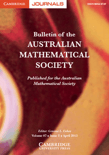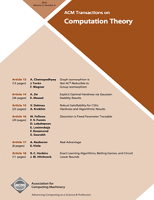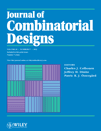
Journal of Combinatorics
Scope & Guideline
Exploring the Depths of Combinatorial Theory
Introduction
Aims and Scopes
- Graph Theory:
A significant portion of the journal's articles revolves around graph theory, including topics like graph connectivity, domination, coloring, and Hamiltonicity. Researchers explore both classical problems and new approaches to graph-related challenges. - Combinatorial Designs:
The journal features research on combinatorial designs, such as block designs, Steiner systems, and Latin squares. These studies often investigate the existence, construction, and properties of various design structures. - Enumeration and Counting:
Papers often delve into enumeration problems, counting specific combinatorial objects, such as paths, trees, and permutations. Techniques from algebraic combinatorics and generating functions are frequently employed. - Extremal Combinatorics:
Research on extremal combinatorics, which deals with the maximum or minimum size of a collection of combinatorial objects under certain constraints, is a core focus. This includes problems related to Ramsey theory and Turán-type results. - Algebraic Combinatorics:
The journal also addresses connections between combinatorics and algebra, including studies on algebraic structures associated with combinatorial configurations, such as polynomial invariants and group actions. - Applications in Computer Science:
Many contributions discuss the applications of combinatorial concepts in computer science, particularly in algorithm design, data structures, and computational complexity.
Trending and Emerging
- Probabilistic Combinatorics:
There is a growing interest in probabilistic methods and techniques, as researchers use probabilistic models to tackle combinatorial problems. This approach is becoming increasingly prominent, especially in the context of random graphs and structures. - Algorithmic Combinatorics:
The intersection of combinatorics and algorithms is gaining traction, with more studies focusing on algorithmic aspects of combinatorial problems. This includes the design and analysis of algorithms for combinatorial optimization and enumeration. - Combinatorial Optimization:
Research on combinatorial optimization, particularly involving graph-based problems and network design, is on the rise. This reflects a broader trend towards practical applications of combinatorial theory in operations research and computer science. - Applications of Combinatorics in Data Science:
The application of combinatorial techniques in data science and machine learning is emerging as a significant area of interest. Researchers are exploring how combinatorial structures can inform data analysis, feature selection, and model building. - Interdisciplinary Research:
There is an increasing trend towards interdisciplinary research, where combinatorial methods are applied in diverse fields such as biology, chemistry, and social sciences. This reflects the versatility and applicability of combinatorial principles across various domains.
Declining or Waning
- Classical Ramsey Theory:
Research specifically centered on classical Ramsey theory has seen a decline. Although foundational, many classical results are well-established, leading researchers to explore more novel or applied areas of combinatorics. - Geometric Combinatorics:
The emphasis on geometric aspects of combinatorics, such as arrangements of points in space and convex hulls, appears to be waning. This may be due to a shift towards more abstract combinatorial structures and graph theory. - Matrix Theory in Combinatorics:
Papers focusing on the intersection of combinatorics and matrix theory, while still relevant, seem to be less frequent. This may suggest a narrowing of interest to more specific applications or techniques. - Applications to Theoretical Physics:
The application of combinatorial techniques to problems in theoretical physics, particularly in areas like statistical mechanics or quantum computing, has declined. Researchers may be pivoting to other interdisciplinary applications. - Old Techniques in Enumeration:
Some traditional counting techniques and classical enumeration problems are becoming less popular, as researchers seek innovative methods and newer frameworks, such as probabilistic and analytic combinatorics.
Similar Journals

BULLETIN OF THE AUSTRALIAN MATHEMATICAL SOCIETY
Elevating Mathematics: A Journal of DistinctionBULLETIN OF THE AUSTRALIAN MATHEMATICAL SOCIETY is an esteemed journal dedicated to advancing the field of mathematics, published by Cambridge University Press. Since its inception in 1969, this periodical has fostered scholarly communication and showcased pivotal research in various domains of mathematics, now projected to continue until 2024. With an impact factor that places it in the Q2 category of miscellaneous mathematics research, it holds a notable position among its peers, ranking 215th out of 399 in the Scopus database. Though it does not currently offer open access options, the journal remains a vital resource for researchers, professionals, and students seeking to deepen their understanding of mathematical advancements. The Bulletin serves as a crucial platform for disseminating original research, comprehensive reviews, and insightful perspectives that navigate the complexities of mathematics today, ensuring the community is well-informed and engaged.

Analele Stiintifice ale Universitatii Ovidius Constanta-Seria Matematica
Connecting Ideas and Insights in the World of MathematicsAnalele Stiintifice ale Universitatii Ovidius Constanta-Seria Matematica is a prominent open-access journal established by OVIDIUS UNIV PRESS in Romania, dedicated to advancing the fields of mathematics, specifically in Analysis and Applied Mathematics. Since its inception, the journal has emphasized the dissemination of high-quality research, making it accessible to a global audience. With an ISSN of 1224-1784 and E-ISSN 1844-0835, it has positioned itself within the academic community, achieving a respectable Q3 ranking in both analysis and applied mathematics in 2023, reflecting its commitment to rigorous scholarship. The journal spans a considerable publication window from 2009 to 2024, catering to the ongoing developments in mathematical sciences and their applications. Researchers, professionals, and students alike will find valuable insights and contributions that enrich their understanding and foster collaboration within the mathematical community. The journal's headquarters is based at the Faculty of Mathematics & Computer Science, Bulevardul Mamaia 124, Constanta, Romania.

Contributions to Discrete Mathematics
Innovating the discourse in discrete mathematics.Contributions to Discrete Mathematics, published by the Department of Mathematics and Statistics at the University of Calgary, serves as a vital platform for disseminating innovative research within the dynamic field of discrete mathematics and combinatorics. Established in 2008, this journal has rapidly gained recognition, currently holding a Q3 classification in discrete mathematics and combinatorics for 2023. As it aims to foster academic dialogue and share groundbreaking discoveries, the journal showcases high-quality peer-reviewed articles that cover a range of topics, from theoretical explorations to practical applications. Although it currently operates under a traditional subscription model, there is a growing commitment to enhancing access options, ensuring that critical knowledge is available to researchers and practitioners alike. With its notable Scopus ranking of #50 out of 92 within its category, this journal is positioned as an important resource for students, academics, and industry professionals who seek to stay at the forefront of discrete mathematics research.

ACM Transactions on Computation Theory
Fostering Collaboration in Cutting-edge Computational Research.ACM Transactions on Computation Theory, published by the Association for Computing Machinery, is a prestigious journal dedicated to advancing the field of computation theory and theoretical computer science. With an ISSN of 1942-3454 and an E-ISSN of 1942-3462, this journal serves as a vital resource for researchers and professionals seeking to explore groundbreaking developments in computational models, algorithms, and their mathematical foundations. The journal's rigorous standards have earned it a significant position within the academic community, as evidenced by its 2023 category quartiles, ranking in the Q1 category for Computational Theory and Mathematics and Q2 for Theoretical Computer Science. Although it operates through traditional subscription access, it maintains a critical role in disseminating cutting-edge research and fostering collaboration among experts in the United States and beyond. As an influential platform, ACM Transactions on Computation Theory is committed to contributing to the ongoing dialogue and advancement of computation theory, making it essential reading for anyone passionate about this dynamic field.

DISCRETE MATHEMATICS
Navigating the landscape of theoretical computer science.DISCRETE MATHEMATICS, published by Elsevier, is a leading journal dedicated to the field of discrete mathematics and combinatorics, with a distinguished presence in the academic community since its inception in 1971. With an ISSN of 0012-365X and an E-ISSN of 1872-681X, this esteemed journal has firmly established itself within the Q1 category for Discrete Mathematics and Combinatorics, and Q2 for Theoretical Computer Science as per the 2023 metrics, underscoring its pivotal role in advancing research in these vital areas. DISCRETE MATHEMATICS is highly regarded, reflected in its Scopus rankings, where it stands at #44 out of 92 in its primary category, contributing significantly to the global discourse on complex mathematical theories and applications. Published from the Netherlands, the journal serves as a crucial resource for researchers, professionals, and students looking to stay informed about the latest innovations and methodologies in discrete mathematics. Though currently not an open-access journal, DISCRETE MATHEMATICS continues to foster a vibrant scholarly community through rigorous peer-reviewed research, promoting a deeper understanding of the mathematical structures that underpin both theoretical and applied science.

CANADIAN JOURNAL OF MATHEMATICS-JOURNAL CANADIEN DE MATHEMATIQUES
Exploring the frontiers of mathematical research.Canadian Journal of Mathematics - Journal Canadien de Mathématiques is a prestigious peer-reviewed journal published by Cambridge University Press, which aims to advance the field of mathematics through the dissemination of high-quality research articles. With its ISSN 0008-414X and E-ISSN 1496-4279, the journal plays a pivotal role in fostering mathematical research and collaboration. It has been recognized for its impactful contributions, currently holding a category quartile ranking of Q2 in Mathematics (miscellaneous) for 2023 and sits in the 66th percentile among its peers according to Scopus rankings. As the journal continues its convergence from its inception in 1994 through to 2024, it remains a vital resource for researchers, professionals, and students seeking to stay at the forefront of mathematical developments. The journal does not operate under an open access model, allowing for a curated collection of articles that adhere to rigorous academic standards.

ELECTRONIC JOURNAL OF COMBINATORICS
Advancing the Frontiers of Combinatorial MathematicsELECTRONIC JOURNAL OF COMBINATORICS, an esteemed publication in the field of combinatorial mathematics, has been a significant platform for innovative research since its inception in 1996. Published by the ELECTRONIC JOURNAL OF COMBINATORICS, this open-access journal has made its complete repository freely available since 2014, encouraging broad international collaboration and dissemination of knowledge. The journal maintains a robust reputation, boasting various category quartiles including Q1 rankings in Applied Mathematics and Discrete Mathematics, highlighting its importance in advancing research and applications in these critical fields. With a clear commitment to showcasing high-impact work and contributing to the ongoing discourse in computational theories, the journal appeals to researchers, professionals, and students alike. Scholars can access a wide array of rigorous articles that explore the latest trends and developments in combinatorial techniques, geometry, and topology, making this journal an essential resource for anyone vested in mathematical sciences. For more information, please refer to their office based at the University of Delaware, Department of Mathematical Sciences.

ARS Mathematica Contemporanea
Pioneering Insights in Contemporary MathematicsARS Mathematica Contemporanea, published by UP FAMNIT in Slovenia, stands as a pivotal journal within the fields of algebra, number theory, discrete mathematics, geometric topology, and theoretical computer science. Since its inception in 2011, this journal has consistently provided a rich platform for innovative research, garnering a commendable Q2 category ranking in various mathematical domains, including Algebra and Number Theory, and Geometry and Topology, showcasing its growing influence and prestige in the academic community. With an increasing Scopus rank—particularly notable in Algebra and Number Theory at the 71st percentile—ARS Mathematica Contemporanea is dedicated to publishing high-quality, peer-reviewed content that advances the frontiers of mathematical knowledge. The journal’s commitment to open access ensures that valuable research is readily available to scholars, practitioners, and students alike, fostering collaboration and dissemination of ideas across the globe. As it converges towards its dedicated timeline extending to 2024, ARS Mathematica Contemporanea remains a crucial resource for those engaged in mathematical research, presenting an array of theoretical and practical insights that define contemporary mathematical discourse.

JOURNAL OF COMBINATORIAL DESIGNS
Pioneering Research in Combinatorial ApplicationsJOURNAL OF COMBINATORIAL DESIGNS, published by Wiley, is a leading peer-reviewed journal that serves as a vital platform for researchers in the field of discrete mathematics and combinatorics. With an impressive Q1 ranking in the 2023 category, it stands at the forefront of academic discourse, showcasing significant developments and innovative research from 1993 to 2024. The journal is dedicated to the study of combinatorial designs, including their applications in various scientific disciplines, which enhances its relevance among mathematicians and applied scientists alike. Although it operates on a traditional subscription model, the journal continues to attract high-quality submissions, as evidenced by its Scopus rank of #40 out of 92 in Discrete Mathematics and Combinatorics, placing it in the 57th percentile. Its commitment to advancing knowledge in combinatorial theory and applications makes it an essential resource for professionals, researchers, and students seeking to deepen their understanding and contribute to this dynamic field.

Acta Universitatis Sapientiae-Mathematica
Transforming mathematical challenges into scholarly opportunities.Acta Universitatis Sapientiae-Mathematica is a dynamic and open-access academic journal published by SCIENDO, dedicated to advancing research in the field of mathematics. With its roots grounded in Germany, the journal has made significant strides in promoting scholarly contributions since it became open access in 2013, enhancing accessibility for researchers, professionals, and students alike. Spanning a broad spectrum of mathematical disciplines, including general mathematics, the journal engages with contemporary challenges and offers a platform to explore innovative approaches. Although currently positioned in the Q4 quartile for 2023 within the miscellaneous mathematics category and holding a Scopus rank of #290 out of 399, the journal is committed to fostering intellectual discourse and enhancing the overall quality of mathematics research. The convergence of research presented since 2014 showcases a journey toward improvement and expanding its influence in the mathematical community. Contribute to the vibrant dialogue in mathematics by exploring the latest findings in Acta Universitatis Sapientiae-Mathematica as it continues to evolve in the academic landscape.